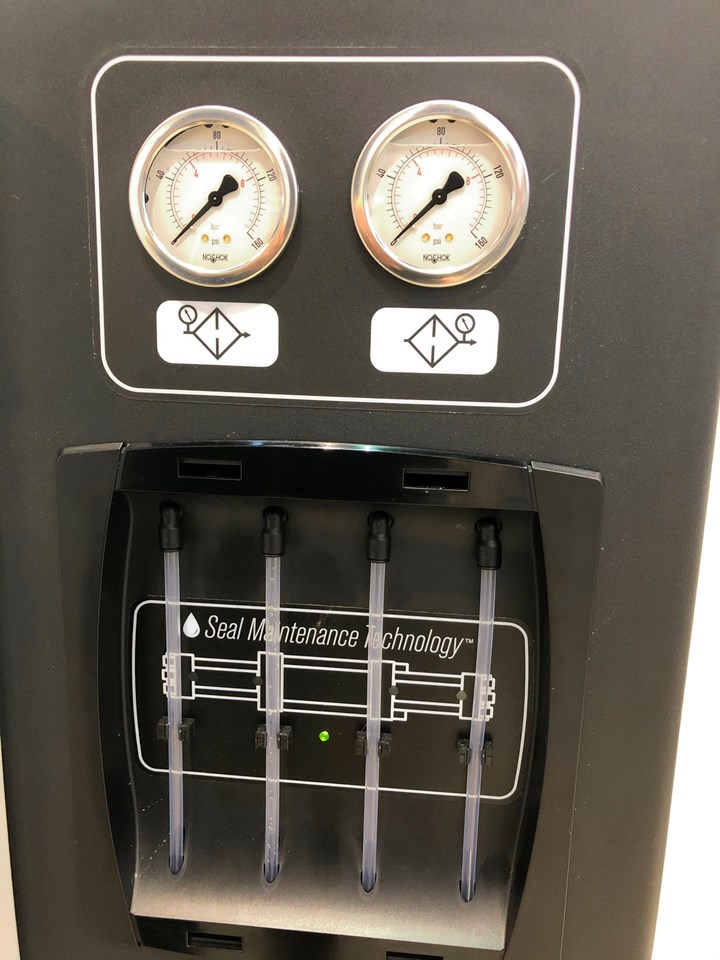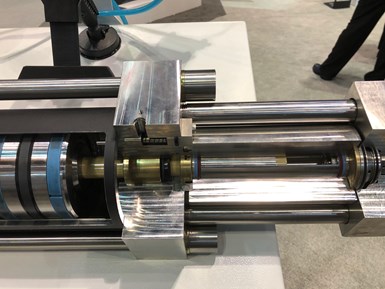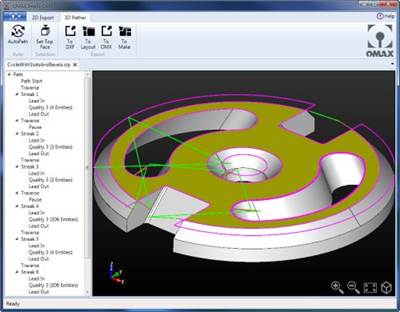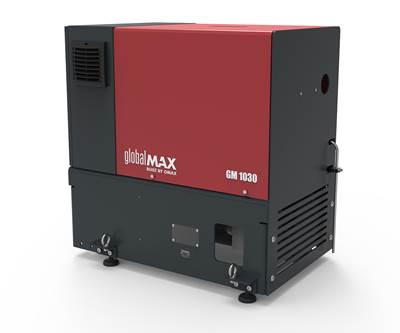Share





There are (because of course there are) channels on YouTube dedicated to waterjet cutting. The most popular, known simply as “Waterjet Channel,” has nearly 800,000 subscribers, many of whom tune in each week to watch the show’s two charismatic hosts slice and dice everything from bowling balls, to Stretch Armstrong dolls, to car batteries, to pizzas.
Clearly there is a visceral satisfaction at work here (who doesn’t want to watch a 60,000 psi beam of water drive abrasive to pierce through an anvil?) that fuel’s the show’s popularity. The video featuring a waterjet cutting through bulletproof glass has nearly 10 million views.
But the channel also demonstrates the versatility of waterjet cutting. Indeed, in metalworking, the benefits of waterjet cutting are widely recognized. Abrasive waterjet machines can cut through nearly any material, they are ideal for heat-sensitive metals and composites, they don’t create burring or rough edges, they expend minimal force on the object being cut, and because they require only minimal fixturing of the workpiece, they eliminate distortion from compression.
But there is a catch.
Waterjet machines have earned a reputation as being maintenance intensive and unpredictable. And regardless of whether it uses direct-drive or intensifier technology, every waterjet machine is prone to leaks.
Typically, seals — a consumable piece of hardware within waterjet pumps — are the culprit. Waterjet technology relies on the extreme pressurization of water, and the soft seals within the machine can withstand that pressure for only so long. Waterjet plungers create pressure by stroking through the seal, which hastens the wear even more. On top of that, factors including pressure levels, cleanliness of the environment and water quality all impact seal life. The system will eventually leak, but all of these factors make it difficult to predict when.
Hypertherm — the New Hampshire-based industrial waterjet and plasma cutting company that started in a two-car garage more than 50 years ago — thinks it has found a solution.
Brain Fluid
Because waterjet machines are often used for cutting thick parts in expensive alloys, the scrap costs from pump failure in the middle of a cut can be significant. This risk was the basis for Hypertherm’s development of its Predictive Waterjet pumps, which provide feedback to the operator directly at the pump or the CNC. The core technology of the predictive pumps is what Hypertherm calls the seal maintenance indicator, or SMI.
The SMI is a feedback indicator that provides a visual depiction of the way in which the system captures the water and oil that normally would leak into a drip pan or on the top deck underneath the intensifier. Those fluids are instead routed into the SMI, the “brain of the system” that monitors the fluid and quantifies it using internal algorithms that calculate the amount of seal life remaining.

The core technology behind Hypertherm’s predictive pumps: the seal maintenance indicator.
The calculation relies on optical gates, pictured above. Each one of the four tubes carry fluid from one end of the seals located on the intensifier: The far left tube routes any high-pressure water that leaks out of the static seal located on the left side (or outer end) of the intensifier. The middle left tube captures both water and hydraulic fluid from the dynamic seal (or inner end) on the left side. The middle right and right-side tubes provide the same action for the right side of the intensifier. The black clips located just below halfway down each tube are the optical gates that calculate the amount of fluid that passes through each tube. By analyzing how long the optical gates are active, the machine algorithms can then quantify the actual fluid leak rate.

The intensifier on a HyPrecision P-75S shows the plunger going through the black rubber seals.
The calculations result in critical thresholds — the amount of time the machine predicts it can run before experiencing a seal failure. The first warning will trigger the stack light to turn from green to a flashing yellow, which indicates that there is between eight and 40 hours of seal life left. A flashing red light indicates less than 30 minutes of seal life remaining.
“These warnings, especially the yellow light warning, are basically the machine indicating that the user should plan for maintenance now,” says Arion Vandergon, Hypertherm’s waterjet marketing manager. “You can keep on running with it, but it's going to run down until you get to the next critical threshold. We give you that buffer to plan your maintenance while the machine continues monitoring until it gets to the critical threshold.”
After maintenance that includes changing the seals, the machine resets the logged hours back to zero. The end result is a system that uses an inherent weakness — fluid leakage — as a data point and asset toward keeping the machine running.
Related Content
Lean Approach to Automated Machine Tending Delivers Quicker Paths to Success
Almost any shop can automate at least some of its production, even in low-volume, high-mix applications. The key to getting started is finding the simplest solutions that fit your requirements. It helps to work with an automation partner that understands your needs.
Read MoreWhere Micro-Laser Machining Is the Focus
A company that was once a consulting firm has become a successful micro-laser machine shop producing complex parts and features that most traditional CNC shops cannot machine.
Read More5 Tips for Running a Profitable Aerospace Shop
Aerospace machining is a demanding and competitive sector of manufacturing, but this shop demonstrates five ways to find aerospace success.
Read MoreHow to Successfully Adopt Five-Axis Machining
While there are many changes to adopt when moving to five-axis, they all compliment the overall goal of better parts through less operations.
Read MoreRead Next
3D Tool Path Software Supports Waterjet Machining
Jointly developed by Omax and Spatial, the Intelli-CAM software for Omax JetMachining Centers generates 3D tool paths from solid 3D models.
Read More10-hp Waterjet Pump Delivers 30,000 psi for Cutting
Omax has expanded its GlobalMax pump series with a 10-hp version for its GlobalMax JetMachining waterjet machines.
Read MoreSetting Up the Building Blocks for a Digital Factory
Woodward Inc. spent over a year developing an API to connect machines to its digital factory. Caron Engineering’s MiConnect has cut most of this process while also granting the shop greater access to machine information.
Read More































